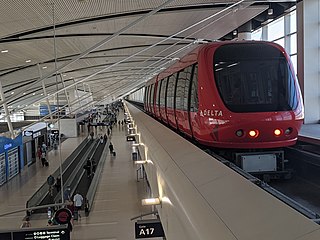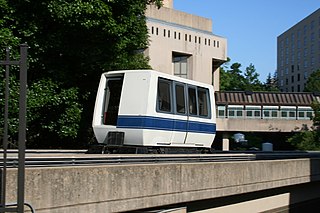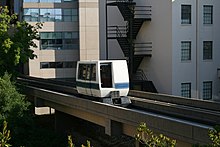
Personal Rapid Transit (PRT), also referred to as podcars or guided/railed taxis, is a public transport mode featuring small low-capacity automated vehicles operating on a network of specially built guideways. PRT is a type of automated guideway transit (AGT), a class of system which also includes larger vehicles all the way to small subway systems. In terms of routing, it tends towards personal public transport systems.

A people mover or automated people mover (APM) is a type of small scale automated guideway transit system. The term is generally used only to describe systems serving relatively small areas such as airports, downtown districts or theme parks.

An automated guideway transit (AGT) or automated fixed-guideway transit or automatic guideway transit system is a type of fixed guideway transit infrastructure with a riding or suspension track that supports and physically guides one or more driverless vehicles along its length. The vehicles are often rubber tired or steel wheeled, but other traction systems including air cushion, suspended monorail and maglev have been implemented. The guideway provides both physical support, like a road, as well as the guidance.

Wellington station is a Massachusetts Bay Transportation Authority (MBTA) Orange Line rapid transit station in Medford, Massachusetts, near the border of Everett. It is located on the Revere Beach Parkway, slightly east of its intersection with Route 28. Wellington functions as a park and ride with more than 1,300 spaces, and a bus hub with 10 routes terminating at the station. The Station Landing development, connected to the station by an overhead walkway, includes residential and retail buildings and additional parking. Wellington Carhouse, the primary repair and maintenance facility for the Orange Line, is located adjacent to the station.
Cabinentaxi, sometimes Cabintaxi in English, was a German people mover development project undertaken by Demag and Messerschmitt-Bölkow-Blohm with funding and support from the Bundesministerium für Forschung und Technologie. Cabinentaxi was designed to offer low-cost mass transit services where conventional systems, like a metro, would be too expensive to deploy due to low ridership or high capital costs.

Morgantown Personal Rapid Transit is a personal rapid transit (PRT) system in Morgantown, West Virginia, United States. The system connects the three Morgantown campuses of West Virginia University (WVU) and the city's downtown area.

The Aérotrain was an experimental Tracked Air Cushion Vehicle (TACV), or hovertrain, developed in France from 1965 to 1977 under the engineering leadership of Jean Bertin (1917–1975) – and intended to bring the French rail network to the cutting edge of land-based public transportation.

Ultra is a personal rapid transit podcar system developed by the British engineering company Ultra Global PRT.

The ExpressTram is an automated people mover system operating at Detroit Metropolitan Wayne County Airport, in Romulus, Michigan, USA. The driverless system transports passengers along Concourse A of the airport's Edward H. McNamara Terminal, which is the world's second-longest airport concourse. Detroit Metro Airport serves as the second largest hub for Delta Air Lines, after Atlanta.

The Zurich Airport Skymetro is an underground airport people mover at Zurich Airport in Switzerland. The 1.1 km (0.68 mi) long system connects the airport's main Airside Center, Gates A, B and D with its mid-field Gates E, passing underneath Runway 10/28. The line opened on 1st September 2003, and was constructed by the Otis Elevator Company.

MiniMetro is a family of cable propelled automated people mover systems built by HTI Group. The vehicles either run on rails or an air cushion and have either a detachable grip or a fixed grip. Leitner has a test track for the vehicles in Vipiteno, Italy. The current maximum capacity of the system is around 8,000 passengers per hour. The latest system installed with the MiniMetro brand was the Miami International Airport eTrain in 2016.
Braniff Jetrail Fastpark System was a suspended monorail system that operated at Dallas Love Field in Dallas, Texas, United States, from April 18, 1970, until January 13, 1974. It was built by Stanray Corporation, Chicago, Illinois, for and operated by Braniff International Airways to transport passengers and their luggage from remote parking lots to the airport terminal.
The Alden staRRcar, short for "Self-Transport Road and Rail Car", was a personal rapid transit (PRT) system designed by William Alden in the 1960s. It originally envisioned small electrically powered cars suitable for short distance trips at low speed within urban areas, which could optionally merge onto tracks that would provide power and guidance for high-speed travel over longer inter-city distances. It was one of the earliest dual-mode vehicles to be proposed, and one of the earliest to be actually built.
ROMAG was a personal rapid transit (PRT) system produced by the American company Rohr, Inc. It featured a linear induction motor that was arranged to provide both traction and suspension in a magnetic levitation system.
The HUD Reports were a series of studies in mass transit systems, funded by the Urban Mass Transportation Administration (UMTA) department of the United States Department of Housing and Urban Development (HUD). The HUD reports were extremely influential in the development of the personal rapid transit (PRT) concept, small pod-like vehicles that automatically travel from point-to-point in extended networks. Their publication in early 1968 sparked off PRT development projects at dozens of companies around the world. In spite of intense interest in the early 1970s, political winds shifted and today there is only one HUD-inspired PRT system in commercial operation, the Morgantown PRT in West Virginia.

The Huntsville Hospital Tram System is an automated people mover system located as part of the Huntsville Hospital System complex in Huntsville, Alabama, United States. Operating on a 1,890-foot (580 m) concrete guideway, the trams serve to connect the Huntsville Hospital with the Huntsville Hospital for Women & Children. At the time of completion, this was the second hospital people mover system in the United States after the Duke University Medical Center Patient Rapid Transit. As of January 2010, this is the only automated people mover system completed in the state of Alabama.

Otis Hovair Transit Systems is a type of hovertrain used in low-speed people mover applications. Traditional people mover systems used wheeled vehicles propelled by electric motors or cable traction, the Hovair replaces the wheels with a hovercraft lift pad. The aim is to reduce guideway complexity and vehicle maintenance. Another benefit is the system's ability to move in all directions, including sideways. The Hovair is the only hovertrain system to be used in commercial service.

The Getty Center Tram is a 0.75-mile (1.21 km) people mover system that serves the Getty Center in Los Angeles. It runs two cable-driven hovertrains each consisting of three Otis Hovair vehicles.

The Tampa International Airport People Movers are a set of automated people mover systems operating within Tampa International Airport. The primary set of people movers are automated guideway transit (AGT) systems that connect the airport's main terminal to four satellite airside concourses. Opened in 1971, the landside/airside shuttles were the first people movers used to transport passengers within an airport terminal and it is today Bombardier Transportation's longest running people mover system. A fifth people mover line known as SkyConnect, which began operating in 2018, connects the main terminal with the airport's economy parking garage and rental car center. In addition, a monorail once connected the main terminal and the long-term parking garage from 1991 until its closure in 2020.















